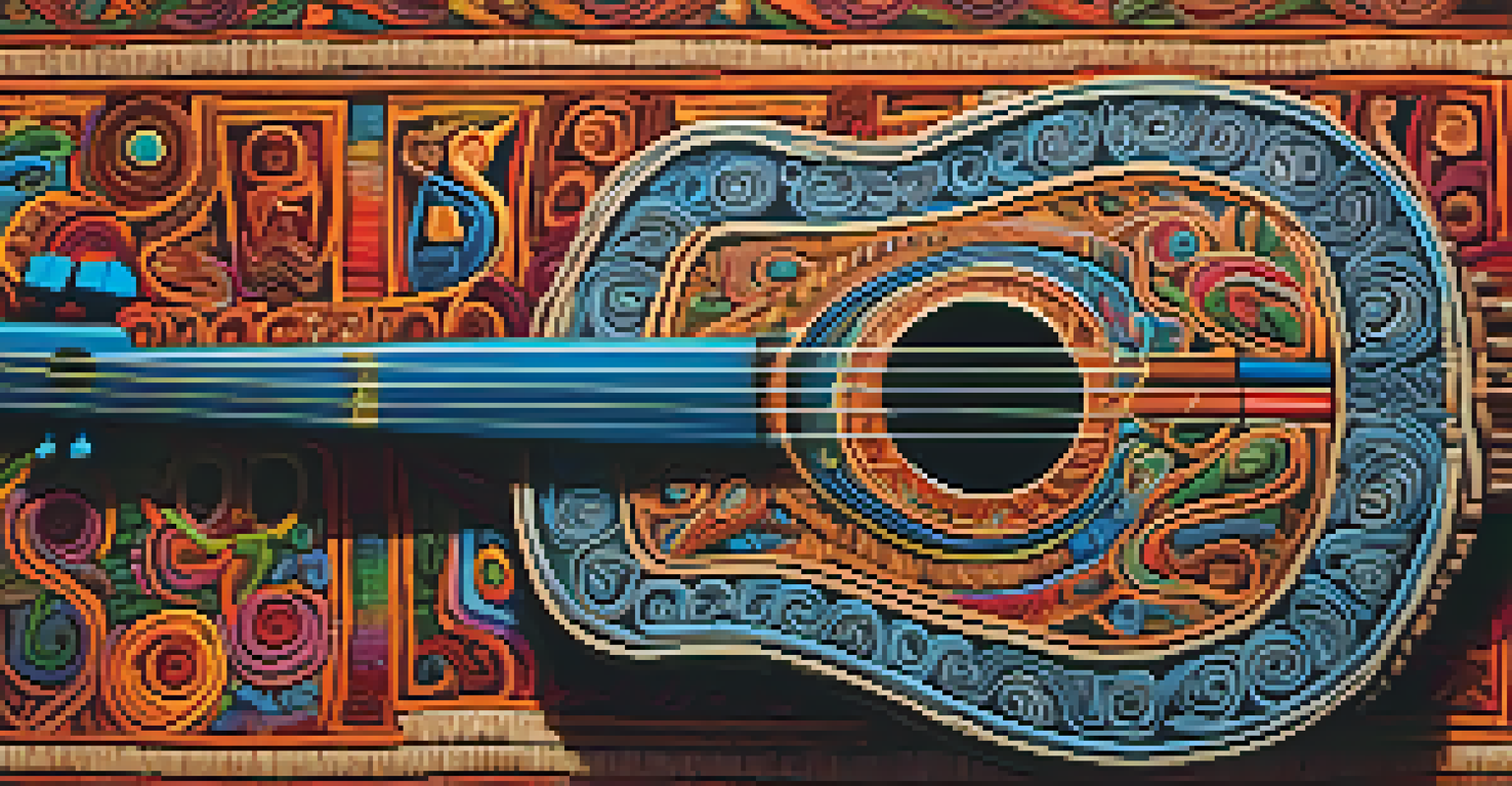Exploring the Historical Significance of Music in Ayahuasca

Understanding Ayahuasca: A Brief Overview
Ayahuasca is a powerful entheogenic brew originating from the Amazon rainforest, traditionally used by indigenous communities for spiritual and healing purposes. It combines two primary ingredients: the Banisteriopsis caapi vine and the leaves of the Psychotria viridis plant. This unique mixture creates a profound psychoactive experience that often leads to introspective journeys and personal revelations.
Music can change the world because it can change people.
In these ceremonies, participants consume Ayahuasca under the guidance of a shaman, who plays a critical role in facilitating the experience. The shaman's expertise is not only in preparing the brew but also in navigating the spiritual landscape that unfolds during the ceremony. This is where music becomes an essential component, enhancing the overall experience.
The music, often referred to as icaro, serves multiple purposes: it helps to set the atmosphere, guides participants through their journeys, and connects them to the spiritual realm. Understanding the significance of music in these ceremonies is key to appreciating the depth of Ayahuasca's cultural and historical context.
The Role of Icaros in Ayahuasca Ceremonies
Icaros are traditional songs sung by shamans during Ayahuasca ceremonies, often characterized by their melodic and repetitive nature. These songs are believed to carry spiritual energy and are thought to invoke healing and protection for the participants. Each icaro is unique, reflecting the shaman's personal experiences and cultural background.

The melodies and lyrics of icaro can vary widely, with some being passed down through generations while others are newly composed in response to specific situations. This adaptability showcases the dynamic nature of the music within Ayahuasca traditions, highlighting how it evolves while maintaining its core purpose of guidance and support.
Ayahuasca's Healing Power
Ayahuasca ceremonies utilize music, particularly icaro, to facilitate emotional healing and personal transformation.
Participants often report that the icaro resonates with them on a deep emotional level, helping them to confront their fears, traumas, or unresolved issues. This bond between the music and the individual enhances the transformative potential of the Ayahuasca experience, making it a vital aspect of the ceremony.
Cultural Significance of Music in Indigenous Communities
For indigenous communities in the Amazon, music is more than just an art form; it is a vital part of their cultural identity and spiritual practice. It serves as a medium for storytelling, preserving their history and traditions, and passing down knowledge through generations. The integration of music in Ayahuasca ceremonies reflects this broader cultural significance.
Music is the shorthand of emotion.
In many cases, the songs are tied to specific rituals, legends, or natural elements, reinforcing the connection between the community and their environment. This deep-rooted relationship with music fosters a sense of unity and belonging among community members, enhancing the collective experience during Ayahuasca ceremonies.
The recognition of music's cultural importance has led to a resurgence of interest in preserving these traditions, as both indigenous and non-indigenous people seek to understand and participate in these powerful practices. As a result, the historical significance of music in Ayahuasca is increasingly acknowledged and celebrated.
The Impact of Western Influence on Ayahuasca Music
As Ayahuasca practices have gained popularity in the Western world, the music associated with these ceremonies has also evolved. Western influences can be seen in the incorporation of various musical styles, instruments, and sounds that were previously absent in traditional settings. This blending of cultures creates a unique experience for participants but also raises questions about authenticity.
Some shamans have embraced these changes, seeing them as an opportunity to share their culture with a broader audience. Others, however, express concern that such adaptations may dilute the spiritual and cultural significance of the music. This tension highlights the delicate balance between honoring tradition and adapting to modern contexts.
Cultural Significance of Icaros
Icaros are essential in Ayahuasca ceremonies, reflecting the shaman's experiences and connecting participants to their cultural roots.
Regardless of the debate, the presence of diverse musical influences in Ayahuasca ceremonies offers participants a richer auditory experience, enhancing their journey. It also invites a dialogue about the importance of preserving indigenous practices while acknowledging the evolving nature of cultural expression.
Music as a Healing Tool in Ayahuasca Experiences
Music plays a crucial role in the healing process during Ayahuasca ceremonies, acting as a catalyst for emotional release and personal transformation. The sounds and melodies can evoke powerful feelings, helping participants confront and process their emotions in a safe environment. This therapeutic aspect of music underscores its significance within the Ayahuasca experience.
For many, the icaro serves as a guide, leading them through challenging moments and providing comfort during intense emotional breakthroughs. The shaman's skilled use of music can help participants navigate their inner landscapes, making the journey feel more manageable and supportive.
Research has shown that music can have profound effects on mental health and well-being, further highlighting its importance in Ayahuasca ceremonies. As participants engage with the music, they often find clarity and insight, ultimately fostering healing and growth.
Modern Interpretations of Ayahuasca Music
In recent years, a new wave of artists and musicians has emerged, inspired by the rich traditions of Ayahuasca music. These modern interpretations often blend traditional icaro with contemporary genres and experimental sounds, creating a fusion that resonates with a wider audience. This evolution reflects the ongoing journey of Ayahuasca music as it adapts to the changing cultural landscape.
Some musicians aim to preserve the essence of traditional icaro while infusing their work with new ideas and influences. This approach not only honors the past but also invites a fresh perspective on the role of music in spiritual practices. By doing so, they contribute to the ongoing dialogue about the significance of music within Ayahuasca traditions.
Evolving Ayahuasca Music
The integration of diverse musical influences in Ayahuasca practices highlights the balance between tradition and modern adaptation.
As these modern interpretations gain popularity, they offer an accessible entry point for those curious about Ayahuasca and its cultural significance. This accessibility can help bridge the gap between indigenous traditions and contemporary society, fostering greater understanding and appreciation for the role of music in these profound experiences.
The Future of Music in Ayahuasca Traditions
Looking ahead, the future of music in Ayahuasca traditions will likely continue to evolve as it encounters new cultural influences and societal changes. The challenge will be to strike a balance between preserving traditional practices while embracing innovation and adaptation. This ongoing evolution reflects the dynamic nature of culture itself.
As more people engage with Ayahuasca through ceremonies and retreats, the demand for diverse musical experiences will likely grow. This presents an opportunity for artists and shamans to collaborate, creating new forms of expression that honor the roots of Ayahuasca music while expanding its reach.

Ultimately, the historical significance of music in Ayahuasca will remain a vital part of its identity, serving as a bridge between the past and the future. As we continue to explore and celebrate this unique aspect of Ayahuasca culture, we can gain a deeper understanding of the powerful role music plays in our collective human experience.